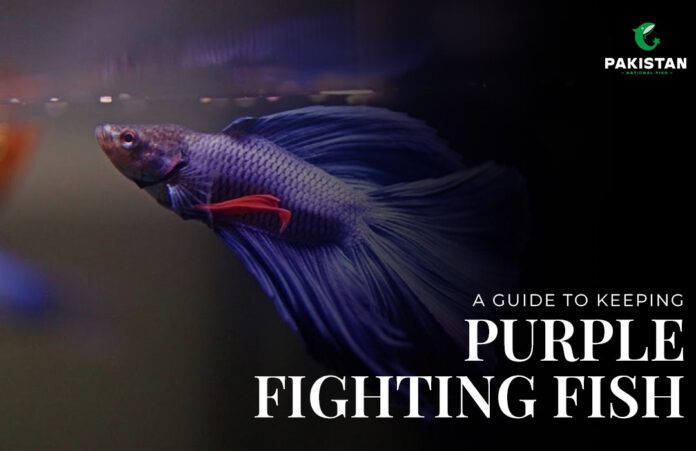The purple betta fish (also known as the Siamese fighter fish) is an increasingly common house fish found in homes all over the world. The purple fighting fish may thrive in an aquarium and have a beautiful look that makes them interesting to watch.
These creatures are among the most popular varieties of pet fish due to their ease of care and low maintenance requirements.
This type of fish can be given small pieces of meat, vegetables, and insects, which should be frozen before serving to your pets. Feeding them frozen food helps keep the tank water clean and prevents algae growth. The fish can live in rooms with temperatures ranging from 72 to 86 degrees Fahrenheit.
Why Are Purple Fighting Fish So Unique?
The main reason why pure purple betta fish are so rare is due to their genetics. They are not a natural colour for betta fish. Instead, they’re the outcome of selected breeding. The true purple betta obtains its colour from a rare genetic abnormality.
Although breeding blue, pink, red, and black bettas increases your chances of receiving this mutation, obtaining a pure purple betta is entirely dependent on luck. There is almost nothing you can do to improve the probability of breeding a pure purple betta. Blue-purple bettas are somewhat more common than pure purple bettas, although they are still relatively unusual for the same reason.
Breeding of Purple Betta Fish
Many individuals have discovered purple bettas by crossing a royal blue male and a blue-and-red female. Others have developed purple bettas by combining a pink male with a white betta female. Yet, neither of these combinations guarantees a purple betta offspring.
If you think you’re up to the challenge, reproducing purple bettas might be worth a shot. Since betta fish are such a demanding breed, this may not be the best endeavour for a beginner fish breeder.
Types of Purple Betta Fish
Purple bettas come in many distinct types. The most frequent type is the Crowntail, sometimes known as the Veiltail. This type features lengthy fins that trail behind it. It features a body stripe that is virtually the same colour as its fins, as well as a black tail fin with a blue tint.
The true purple betta can grow up to 4.7 inches (12 cm) in length and 1.5 inches (4 cm) in width. It has a spherical body coated in scales that give it the illusion of being smooth and silky, but it contains mucous glands that produce a sticky substance that it uses to connect to surfaces.
Suitable Environment
Pure purple bettas prefer soft water to hard water and require soft or medium-soft pebbles at the bottom of their tanks. It will perform well in any substrate you choose as long as it is not chemically altered or processed.
Betta fish require a place to hide to feel safe, as they are naturally shy and will avoid conflict with other tankmates. Create hiding spots such as little caves, flowerpots, or ornamental plants. Live aquatic plants produce oxygen and contribute to a healthy atmosphere in your betta’s habitat; employ a variety of varieties so that the fish can find both nourishment and shelter at the same time.
Tips for Nourishing Purple Fighting Fish
Nourishing purple fighting fish involves providing them with a healthy environment and proper care. Here are some tips to ensure their well-being:
- Bettas are carnivorous and need a protein-rich diet.
- High-quality Betta pellets or tropical flakes should constitute the primary diet.
- Supplement with live or frozen foods, such as brine shrimp, daphnia, or bloodworms, to add diversity and nourishment.
- Feed your Betta once or twice a day, serving only what they can swallow in 2-3 minutes.
- Avoid excessive feeding because too much food might dirty the tank and kill the fish.
How Much Does Purple Betta Fish Cost?
The purchase price of a Betta Fish is usually determined by its colour and variation. Purple Betta fish, like all Betta fish, come in a variety of colours. This will impact their overall pricing. Most purple Betta fish cost about ten dollars, while some can cost up to twenty-five dollars. These aren’t particularly pricey fish.
It can be difficult to locate a “true” purple Betta fish, however. The majority will be some shade of purple-blue. True purple Betta fish will be the most expensive, whereas blueish variations may be less costly.
Can Purple Betta Fish Suitable Tankmates?
No, these fish cannot be kept alongside other fish in most circumstances. They’re territorial and aggressive. Most will attack everything that even resembles a Betta fish. However, aggression varies amongst species. They tend to have distinct personalities. Some will attack anything that moves, but others can coexist with other fish.
While choosing tankmates, make sure they don’t have any bright colours. Your Betta will perceive these fish as competitors, which is rarely a good thing. They should also live in an alternate depth of water than the Betta. If another fish hangs around at the top, the Betta may attack them.
Conclusion
Raising a Purple Fighting Fish demands attention and knowledge to ensure their well-being and pleasure. By providing an appropriate home, a balanced diet, and constant attention, you can enjoy your Betta’s brilliant beauty and fascinating personality for many years. Remember that each Betta has a distinct personality, so tailor your care routine to your fish’s specific demands. With the appropriate attitude, your Purple Betta will be a beautiful addition to your aquarium as well as an interesting pet to observe and play too.


